Light stencils are a great way to expand your night photography and light painting. Claire gets you started
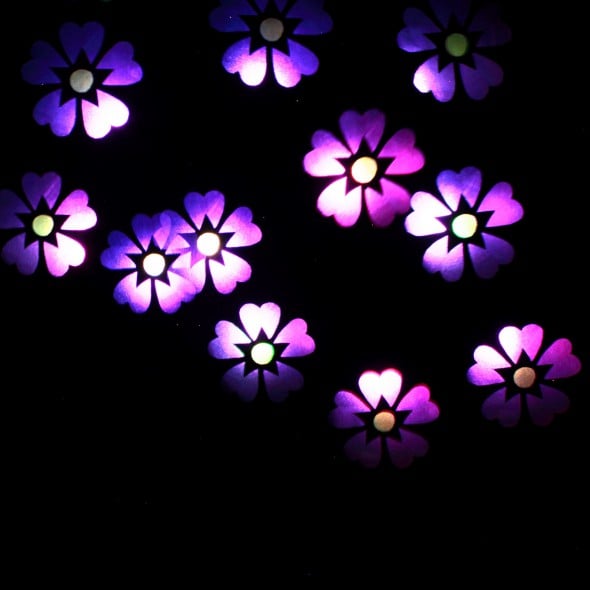
All images by Claire Harper
Over the past two years I’ve really been enjoying learning to light paint, and I’ve always wanted to improve my pictures. Having come across some amazing pictures made using light stencils, and having always enjoyed drawing and being quite crafty myself, I thought I would give it a go.
I discovered adding light stencils to your night photography and light painting can create some brilliant results, and what’s more light stencils are easy to make and fun to use.
What you need:
- Light stencil box (easy-to-follow instructions on how to make your own light stencil box on PDF below)
- Stencils (either downloaded to be cut out or designed and made yourself)
- Bright torch or remote flash
Making your Light Stencil Box & Stencils
Materials/tools:
- Light Stencil Box Template (link to download PDF here)
- Thick corrugated card or black easy-to-cut plastic correx board 1m² (readily available online)
- Ruler
- Sharpie pens
- Duct tape
- A4 plastic pockets
- Scissors
- Craft / Stanley knife
- Stencils (either designed and made yourself or download my basic PDF stencils here)
Tip: Correx board is waterproof and will last longer than cardboard.
Assembling the stencil box
- Print out the five A3 pages that make the stencil box template to fit A4 stencils (you can print out A4 size to make a smaller stencil box)
- Clear yourself enough space
- Cut out and stick the five parts together, also cutting out the centre inner square (as shown below)
- Draw around the template on your cardboard box or correx board in Marker
- Very carefully cut the stencil box out using craft knife, stanley knife or scissors
- With the card / correx board cut out from the centre square, cut a strip approximately 1 inch wide to be used as a handle, as indicated on the template.
- Using a ruler and scissors or craft knife, carefully score around the edge of the front of your box, ensuring you only lightly score the top layer of card / correx board and not actually cut right through – this helps with the next stage, assembling your box:
- Turn your cut-out stencil box over and carefully fold in the sides each in turn and using duct tape secure the sides of the box. Also duct tape around the front where you scored the bends.
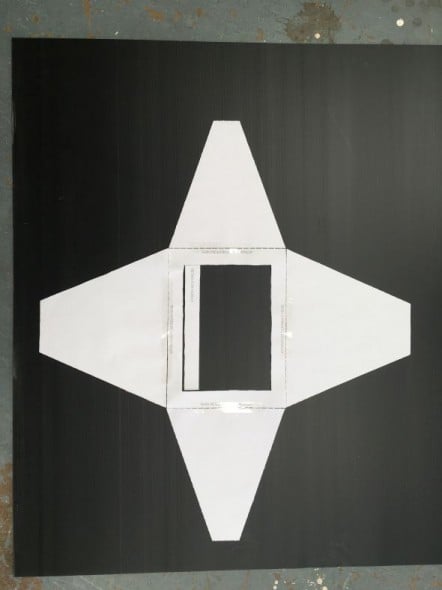
Box template on correx
Tip: Use a couple of layers of duct tape on each side to prevent light leaks
- Now that the main part of your box is assembled, duct tape an A4 plastic pocket to the front of the box (you will have to adjust the size of the plastic pocket to fit if making a smaller box), covering the large hole in front, taping 3 sides but leaving the side that can be ‘opened’ open, with no tape, this will be used to slot your stencils into, it also defuses the light from torch or flash.
- The open side of the plastic pocket will be the Top of your box, attach the handle previously cut out with duct tape to be top of your box (as shown on completed box picture below).
Your basic light stencil box is now complete.
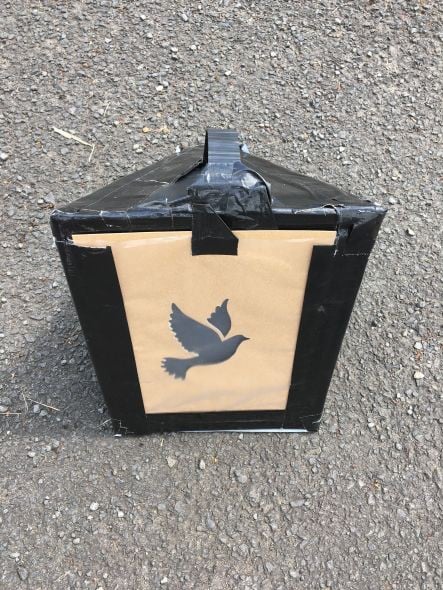
A complete stencil box
Tip: If, like me, you prefer using a torch to a remote flash, the opening for a torch or flash to fit into can be adjusted to size, again by using duct tape (I tape and then place paper on the sticky side to re-enforce) and of course this can be removed again if necessary.
If you’re using correx board, it is easy to cut or remove the tape holding the sides together to flat pack for easy transportation.
Making the stencils
I use the back of ‘do not bend’ envelopes as they are nearly the perfect fit for the box and only require slight trimming if you have made your box with A3 sheets on the PDF above (for smaller size boxes adjust stencil size as necessary). The card is thick enough not to let any light through, and thin enough to cut quite delicate stencils easily.
This PDF has a few stencils designs I’ve made to get you started:
How to create the stencils:
- Making sure your design is central. Carefully cut out any shape you require, remembering to leave at least 1.5 inches around the outside to ensure correct fit to box.
- Once you have cut the stencil, cut a sheet of plastic from your leftover A4 pockets and tape to the stencil (as pictured below) or use sticky-back plastic on both sides. This acts as an extra layer to help diffuse the light correctly.
- At this point you can colour in your stencils if required with sharpie markers (as below). You do not need to be that careful with this part, just ensure the portion of the stencil where the light will come through is fully coloured. I often go over the colour twice to ensure a nice, bright, even colour.
- Slot the stencil into the A4 pocket attached to your light stencil box and you’re ready to start stencilling!
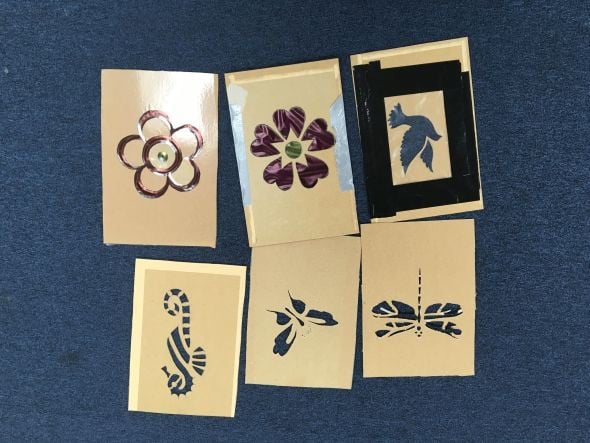
Some completed stencils
Using light stencils in photography
Whether you want to use stencils to add more to your light painting or just on their own, you can get some amazing results!
To use your light stencil box:
- Slot your stencil into your box
- Set your camera up on your tripod with your shutter release (my normal light painting settings are about f/9 and ISO 200 in bulb mode, adjust to suit) and focus as normal.
- Standing in front of your camera and holding your stencil box by the handle with the front of the box pointing to the camera, position your torch or remote flash in the small opening at the back of the box.
- Open your shutter with your shutter release and experiment with the stencils, I find just a quick on/off with a torch is sufficient, remembering to move location with every flash so your stencils do not overlap.
Light stencilling does take a little practice and experimentation is the key.
Once you have mastered getting your stencils in shot, you can use your stencils to add to your light painting, any night photography and even adding something different to portraits.
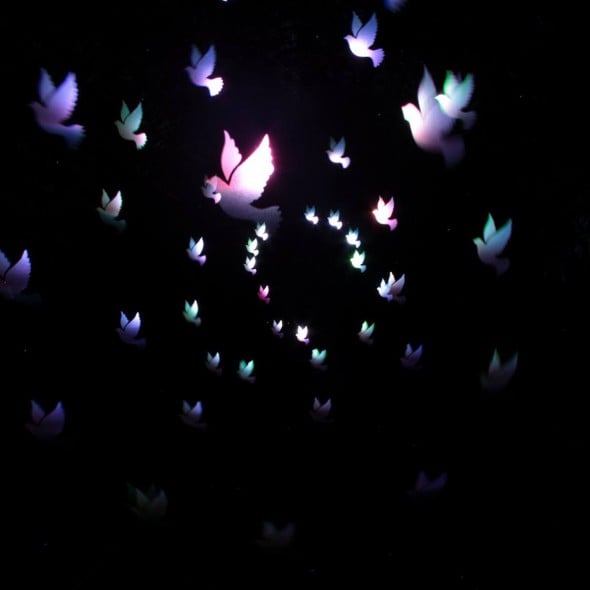
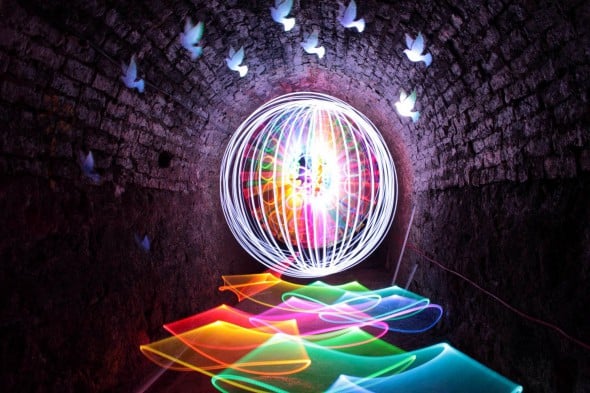
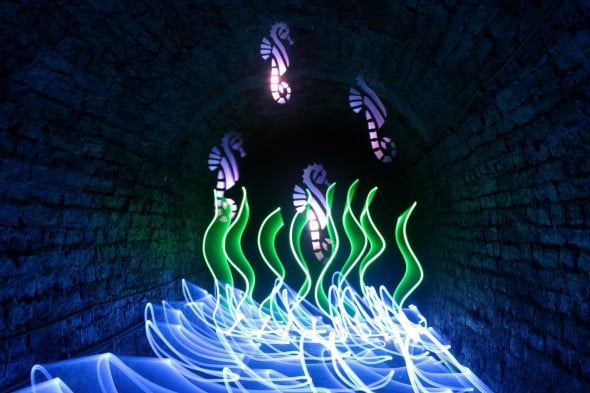
A few examples of the creative images you can make using stencils
Many thanks to Robyn Flemming for modelling the light flowers and Richard Cowdery for drawing up the design of the stencil box.
About the Author
Claire Harper is a photographer, tour guide and light painter. Follow her on Twitter @ClaireHarpz

